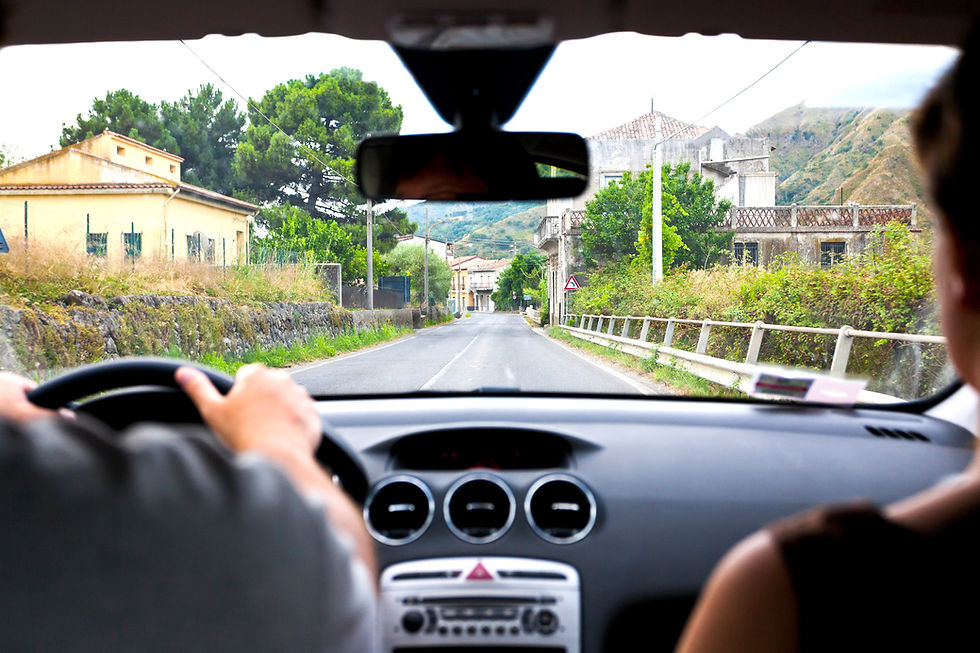What Can You Do About Motion Sickness?
- Fysiobasen

- 12 hours ago
- 3 min read
Motion sickness — also known as kinetosis — is a common and unpleasant condition that affects both children and adults.
Symptoms like nausea, dizziness, headache, and vomiting can ruin a car trip or even make short journeys unbearable for sensitive individuals.
Fortunately, there are proven ways to prevent and relieve these symptoms. But what exactly causes motion sickness — and what can you do about it?

What Is Motion Sickness – and Why Does It Happen?
Motion sickness occurs when the brain receives conflicting signals from different sensory systems:
The eyes see movement (or lack of it)
The inner ear senses acceleration and changes in direction
The muscles and joints feel stationary
When the brain interprets these conflicting messages, it triggers nausea — an ancient protective response that once helped humans avoid toxins or poisoning.
Why Understanding Motion Sickness Helps
Enables targeted prevention and treatment
Helps choose the right medication or strategy
Reduces anxiety and discomfort during travel
Limitations and Challenges
Not all remedies work for everyone
Children are often more sensitive than adults
Symptoms can appear suddenly and be hard to control
Common Symptoms
Nausea and upset stomach
Dizziness or “heavy head” sensation
Paleness and cold sweating
Rapid breathing or heart rate
Vomiting
Fatigue and irritability (especially in children)
How to Prevent Motion Sickness
Sit in the Right Position
Sit in the front seat when possible
Look straight ahead at the horizon
Avoid reading or looking at screens
Don’t sit backwards or in the rear row
Reduce Visual Distraction
Close your eyes or wear sunglasses in bright light
Avoid focusing on moving objects like screens or books
Stabilize Head and Body
Rest your head against the headrest
Keep movements to a minimum
Ensure Fresh Air
Open a window or use the air vents
Avoid strong odors like perfume, food, or gasoline
Eat Light Before Traveling
Eat light meals such as crackers, toast, or bananas
Avoid heavy, greasy, or spicy food
Don’t travel on an empty stomach
Take Breaks
Stop and walk every 1–2 hours
Fresh air and movement help reset your senses
Remedies and Medications
Travel Sickness Tablets (Antihistamines)
Examples: Meclizine (Postafen), Cyclizine (Marzine)
Work best if taken 1–2 hours before travel
May cause drowsiness — avoid driving after use
Acupressure Wristbands (Sea-Band)
Apply pressure to the P6 (Neiguan) point on the wrist
Research shows moderate effectiveness, especially in children
Ginger
Ginger tea, capsules, or candies can help mild nausea
Proven to reduce motion-induced nausea in several studies
Scopolamine Patch
Used for severe cases, especially sea travel
Apply behind the ear 6–8 hours before departure
May cause side effects like dry mouth or blurred vision
When to See a Doctor
Persistent or severe motion sickness despite self-care
Children refusing to travel due to nausea
Motion sickness accompanied by fever, headache, or confusion
Symptoms lasting long after travel ends
Motion Sickness in Children
Children between ages 2 and 12 are particularly vulnerable.
Tips for parents:
Use a forward-facing car seat so the child can see ahead
Avoid screens and reading during the trip
Bring water, a bag, and wipes for emergencies
Give medications only with medical or pharmacy guidance
Take frequent breaks and keep a calm atmosphere
Summary
Motion sickness occurs when the brain receives mixed signals from the eyes, inner ear, and body.
By sitting correctly, eating light, keeping fresh air flowing, and using appropriate remedies, most people can reduce or prevent symptoms.
Sources
Reason JT, Brand JJ. (1975). Motion Sickness. Academic Press.
Ernst E, Pittler MH. (2000). Efficacy of ginger for nausea and vomiting: a systematic review of randomized clinical trials. Br J Anaesth, 84(3):367–371.
Hu S, et al. (2011). The efficacy of acupressure for the prevention of motion sickness: a meta-analysis. Travel Med Infect Dis, 9(5):258–262.









